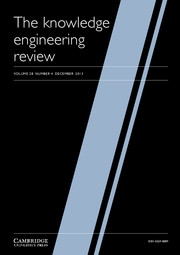Crossref Citations
This article has been cited by the following publications. This list is generated based on data provided by
Crossref.
van Delden, André
and
Moratz, Reinhard
2014.
Spatial Cognition IX.
Vol. 8684,
Issue. ,
p.
299.
Mekni, Mehdi
2015.
Integration of GIS Data for Visualization of Virtual Geospatial Environments.
p.
273.
van de Ven, Jasper
Anastasiou, Dimitra
Dylla, Frank
Boll, Susanne
and
Freksa, Christian
2015.
Ambient Intelligence.
Vol. 9425,
Issue. ,
p.
171.
Claramunt, Christophe
and
Stewart, Kathleen
2015.
Special Issue on Spatio-Temporal Theories and Models for Environmental, Urban and Social Sciences: Where Do We Stand?.
Spatial Cognition & Computation,
Vol. 15,
Issue. 2,
p.
61.
Takemura, Ryo
2015.
Counter-Example Construction with Euler Diagrams.
Studia Logica,
Vol. 103,
Issue. 4,
p.
669.
Tayyub, Jawad
Tavanai, Aryana
Gatsoulis, Yiannis
Cohn, Anthony G.
and
Hogg, David C.
2015.
Computer Vision -- ACCV 2014.
Vol. 9007,
Issue. ,
p.
115.
Nam, Sangha
and
Kim, Incheol
2015.
Qualitative Spatial Reasoning with Directional and Topological Relations.
Mathematical Problems in Engineering,
Vol. 2015,
Issue. ,
p.
1.
Baode, Jiang
and
Qi, Wei Dong-
2016.
An Intersection Model of RCC-5 for Spatial Relationships and its Application.
Journal of Software Engineering,
Vol. 11,
Issue. 1,
p.
102.
Sahraoui Dhelim
Ning, Huansheng
and
Tao Zhu
2016.
STLF: Spatial-temporal-logical knowledge representation and object mapping framework.
p.
001550.
Xu, Bingqing
and
Li, Qin
2016.
A Spatial Logic for Modeling and Verification of Collision-Free Control of Vehicles.
p.
33.
Landsiedel, C.
Rieser, V.
Walter, M.
and
Wollherr, D.
2017.
A review of spatial reasoning and interaction for real-world robotics.
Advanced Robotics,
Vol. 31,
Issue. 5,
p.
222.
Jarvis, Claire H.
Kraftl, P.
and
Dickie, J.
2017.
(Re)Connecting spatial literacy with children’s geographies: GPS, Google Earth and children’s everyday lives.
Geoforum,
Vol. 81,
Issue. ,
p.
22.
Randell, David A.
Galton, Antony
Fouad, Shereen
Mehanna, Hisham
and
Landini, Gabriel
2017.
Medical Image Understanding and Analysis.
Vol. 723,
Issue. ,
p.
718.
Freksa, Christian
and
Kreutzmann, Arne
2017.
International Encyclopedia of Geography.
p.
1.
Randell, David
Galton, Antony
Fouad, Shereen
Mehanna, Hisham
and
Landini, Gabriel
2017.
Mereotopological Correction of Segmentation Errors in Histological Imaging.
Journal of Imaging,
Vol. 3,
Issue. 4,
p.
63.
Della Penna, Giuseppe
Magazzeni, Daniele
and
Orefice, Sergio
2017.
A formal framework to represent spatial knowledge.
Knowledge and Information Systems,
Vol. 51,
Issue. 1,
p.
311.
Thippur, Akshaya
Stork, Johannes A.
and
Jensfelt, Patric
2017.
Non-parametric spatial context structure learning for autonomous understanding of human environments.
p.
1317.
Xu, Bingqing
and
Li, Qin
2017.
A bounded multi-dimensional modal logic for autonomous cars based on local traffic and estimation.
p.
1.
Pushp, Sumant
Bhardwaj, Basant
and
Hazarika, Shyamanta M.
2017.
Mining Intelligence and Knowledge Exploration.
Vol. 10682,
Issue. ,
p.
81.
Binong, Juwesh
and
Hazarika, Shyamanta M.
2018.
Proceedings of the International Conference on Computing and Communication Systems.
Vol. 24,
Issue. ,
p.
327.

